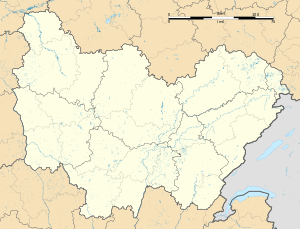Bagnot
Bagnot is a commune in the Côte-d'Or department in the Bourgogne-Franche-Comté region of eastern France.
Bagnot | |
|---|---|
 The Church of the Nativity | |
Location of Bagnot 
| |
 Bagnot  Bagnot | |
| Coordinates: 47°03′36″N 5°04′35″E | |
| Country | France |
| Region | Bourgogne-Franche-Comté |
| Department | Côte-d'Or |
| Arrondissement | Beaune |
| Canton | Brazey-en-Plaine |
| Intercommunality | Rives de Saône |
| Government | |
| • Mayor (2001–2020) | Mary-Claude Thurillat |
| Area 1 | 12.57 km2 (4.85 sq mi) |
| Population (2017-01-01)[1] | 161 |
| • Density | 13/km2 (33/sq mi) |
| Time zone | UTC+01:00 (CET) |
| • Summer (DST) | UTC+02:00 (CEST) |
| INSEE/Postal code | 21042 /21700 |
| Elevation | 189–216 m (620–709 ft) (avg. 197 m or 646 ft) |
| 1 French Land Register data, which excludes lakes, ponds, glaciers > 1 km2 (0.386 sq mi or 247 acres) and river estuaries. | |
The inhabitants of the commune are known as Bagnotins or Bagnotines.[2]
Geography
Bagnot is located some 30 km south of Dijon and 15 km east by north-east of Beaune. Access to the commune is by the D20 from Argilly in the west which passes through the village and continues east to Auvillars-sur-Saône. The D35E goes south from the village to the D973. The A36 autoroute passes through the south of the commune from west to east but has no exit in the commune. The nearest exit is Exit ![]()
The Sereine river flows through the commune and the village from the north-east and continues south-west to join the Meuzin near Palleau. Two tributaries feed the Sereine from the commune - one fed by the Étang de Menans just west of the commune and the other from the Grand Étang west of the village. Another stream rises in the east of the commune and flows east through the Étang Limonet and Étang du Moulin, both just east of the commune, to the Saône river at Glanon.[3]
Neighbouring communes and villages[3]
Administration
| From | To | Name | Party | Position |
|---|---|---|---|---|
| 2001 | 2020 | Mary Claude Thurillat |
(Not all data is known)
Demography
In 2010 the commune had 129 inhabitants. The evolution of the number of inhabitants is known from the population censuses conducted in the commune since 1793. From the 21st century, a census of communes with fewer than 10,000 inhabitants is held every five years, unlike larger communes that have a sample survey every year.[Note 1]
| 1793 | 1800 | 1806 | 1821 | 1831 | 1836 | 1841 | 1846 | 1851 |
|---|---|---|---|---|---|---|---|---|
| 322 | 325 | 385 | 325 | 365 | 362 | 345 | 353 | 339 |
| 1856 | 1861 | 1866 | 1872 | 1876 | 1881 | 1886 | 1891 | 1896 |
|---|---|---|---|---|---|---|---|---|
| 337 | 301 | 304 | 277 | 265 | 250 | 244 | 252 | 250 |
| 1901 | 1906 | 1911 | 1921 | 1926 | 1931 | 1936 | 1946 | 1954 |
|---|---|---|---|---|---|---|---|---|
| 261 | 229 | 201 | 175 | 178 | 141 | 143 | 144 | 134 |
| 1962 | 1968 | 1975 | 1982 | 1990 | 1999 | 2006 | 2010 | - |
|---|---|---|---|---|---|---|---|---|
| 120 | 120 | 118 | 147 | 133 | 124 | - | 129 | - |

Culture and heritage


Civil heritage
The commune has a number of buildings and structures that are registered as historical monuments:
- A Farmhouse at CVO 2 Meix Martin (18th century)

- A Farmhouse at D20 (1842)

- A Town Hall/School at D20 (19th century)

- A Farmhouse at Les Granges de Bagnot (18th century)


- Houses and Farms (18th-19th century)

Religious heritage
The commune has several religious buildings and sites that are registered as historical monuments:
- A Cemetery Cross at D20 (19th century)

- A Presbytery at D20 (19th century)

- The Church of the Nativity (12th century).

See also
External links
- Bagnot on the old National Geographic Institute website (in French)
- Bagnot on Lion1906
- Bagnot on Géoportail, National Geographic Institute (IGN) website (in French)
- Bagnot on the 1750 Cassini Map
Notes and references
Notes
- At the beginning of the 21st century, the methods of identification have been modified by Law No. 2002-276 of 27 February 2002 Archived 6 March 2016 at the Wayback Machine, the so-called "law of local democracy" and in particular Title V "census operations" allows, after a transitional period running from 2004 to 2008, the annual publication of the legal population of the different French administrative districts. For communes with a population greater than 10,000 inhabitants, a sample survey is conducted annually, the entire territory of these communes is taken into account at the end of the period of five years. The first "legal population" after 1999 under this new law came into force on 1 January 2009 and was based on the census of 2006.
References
- "Populations légales 2017". INSEE. Retrieved 6 January 2020.
- Inhabitants of Côte-d'Or (in French)
- Google Maps
- List of Mayors of France (in French)
- Ministry of Culture, Mérimée IA00070878 Farmhouse at CVO 2 Meix Martin (in French)
- Ministry of Culture, Mérimée IA00070879 Farmhouse at D20 (in French)
- Ministry of Culture, Mérimée IA00070876 Town Hall/School at D20 (in French)
- Ministry of Culture, Mérimée IA00070881 Farmhouse at Les Granges de Bagnot (in French)
- Ministry of Culture, Palissy IM21000090 Statue: Sacred Heart (in French)
- Ministry of Culture, Mérimée IA00070874 Houses and Farms (in French)
- Ministry of Culture, Mérimée IA00070880 Cemetery Cross (in French)
- Ministry of Culture, Mérimée IA00070877 Presbytery (in French)
- Ministry of Culture, Mérimée PA00112092 IA00070875 Church of the Nativity (in French)

| Wikimedia Commons has media related to Bagnot. |